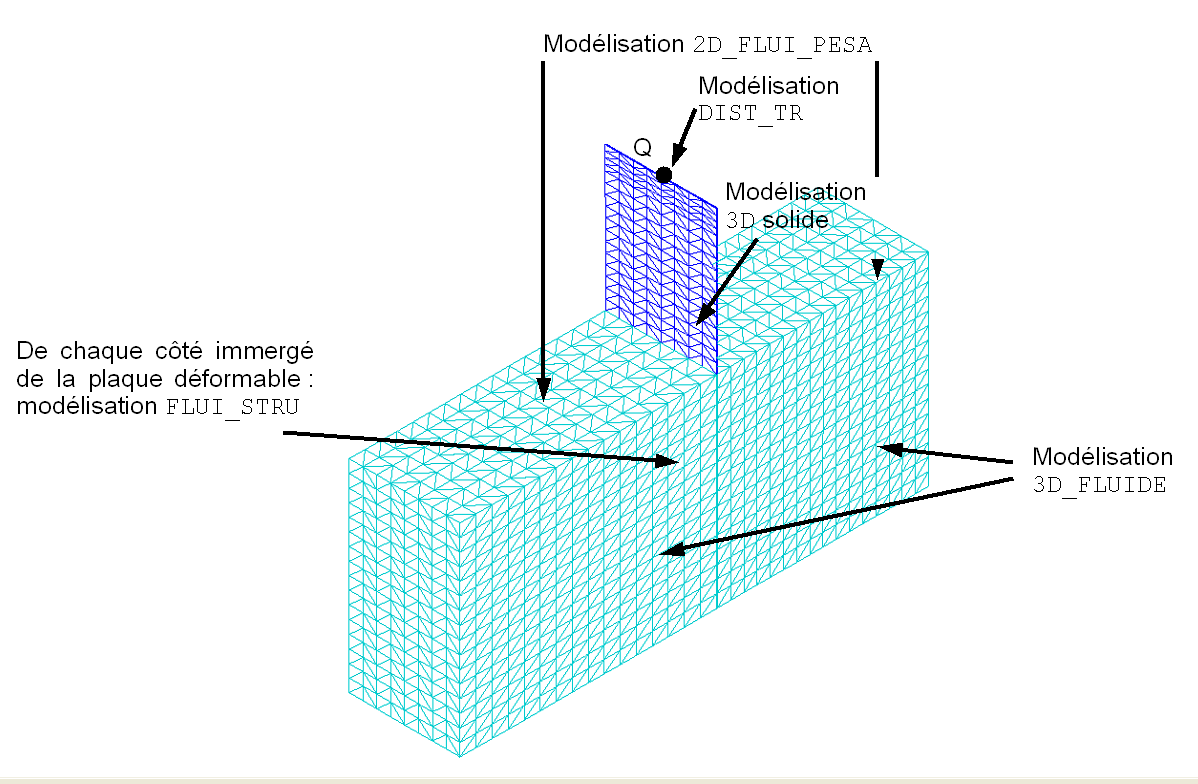3. Modeling A#
3.1. Characteristics of modeling#

The total mesh includes 8163 knots, i.e. approximately 125,000 degrees of freedom,
The point element \(Q\) (modeling DIS_TR) makes it possible to simply represent an accelerometer present in the model in article [bib1],
The deformable plate is modelled by 5120 solid solid elements (3D modeling) pentahedral with 6 knots (10 layers in the thickness for a good approximation of the flexural behavior despite the linearity of the elements),
the free surface is modelled by 512 elements MEFP_FACE3 (2D_ FLUI_PESA modeling) triangles with 3 knots,
the fluid volume is modeled by 24576 fluid elements (3D modeling FLUIDE) tetrahedral fluid elements with 4 nodes.
3.2. Writing boundary conditions#
The bottom of the tank can only move in direction \(x\):
DDL_IMPO =( _F ( GROUP_NO =( “FONDS”, “FONDP”,), DY=0.0, DZ=0.0,),),);
In this direction \(x\), a sinusoidal displacement in time, with a frequency \(\mathrm{1,7704}\mathrm{Hz}\) and an amplitude \(\mathrm{0,001}m\), is imposed on the bottom of the tank:
LFONC = DEFI_LIST_REEL (DEBUT =0.0, INTERVALLE =_F (JUSQU_A =10.0, PAS =0.01,),); FONC = FORMULE (REEL = « ”(REEL: INST) = (0.001) SIN (2*PI*FREQ INST) « ”); DEPLX = CALC_FONC_INTERP (FONCTION = FONC, NOM_PARA =” INST “, LIST_PARA = LFONC,); CHARG_SE = AFFE_CHAR_MECA_F (MODELE = MODELE, DDL_IMPO =_F ( GROUP_NO =( “FONDS”, “FONDP”,), DX= DEPLX,),);
Volume gravity loading is defined as follows:
PESA = AFFE_CHAR_MECA (MODELE = MODELE,
PESANTEUR =_F (GRAVITE =9.81, DIRECTION =( 0.,0., -1.,),),);
3.3. Characteristics of the mesh#
The mesh contains: |
24575 TETRA4 |
5120 PENTA6 |
|
4096 TRIA3 |
3.4. Tested values#
The tests are carried out on the value of the following displacement \(x\) (noted \(\mathit{DX}\)) for various times and for the nodes \(\mathit{N145}\) and \(\mathit{N3119}\).
Identification |
Reference |
\(\mathit{DX}(\mathit{N145},t=\mathrm{0,8}s)\) |
5.162416932321991e-04 |
\(\mathrm{DX}(\mathrm{N145},t=\mathrm{1,4}s)\) |
1.4970110110314375e-04 |
\(\mathrm{DX}(\mathrm{N145},t=\mathrm{2,0}s)\) |
-2.392741313131721e-04 |
\(\mathrm{DX}(\mathrm{N3119},t=\mathrm{1,0}s)\) |
-9.973627272860105e-04 |
\(\mathrm{DX}(\mathrm{N3119},t=\mathrm{1,6}s)\) |
-8.785505656121762e-04 |
\(\mathrm{DX}(\mathrm{N3119},t=\mathrm{2,0}s)\) |
-2.392916161952584e-04 |
We also test the critical eigenvalue calculated with CRIT_STAB.
Identification |
Reference |
CHAR_CRIT |
-2.477264942149 |